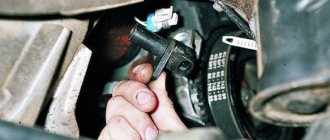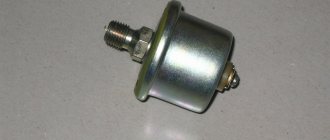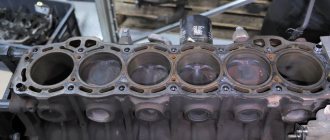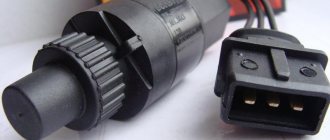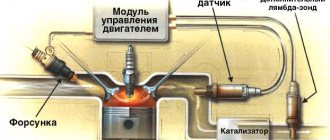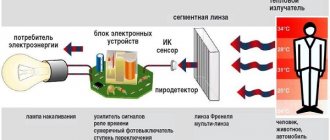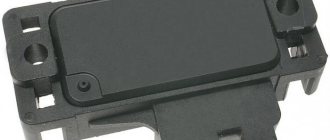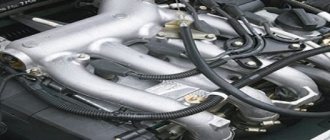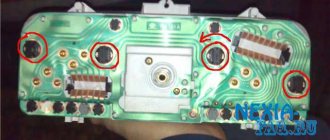Diagnostics and repair of the fuel injection system of a VAZ 21213 car
Transport » Diagnostics and maintenance of the VAZ 21213 car » Diagnostics and repair of the fuel injection system of the VAZ 21213 car
Page 3
DPKV (crankshaft position sensor)
This is the most important sensor in the injection system; it is used to synchronize the operation of the ECU. You have to connect a motor tester to it quite often, so for convenience it is recommended to make an adapter from the connector and the old sensor. As already mentioned, this sensor can also serve as a synchronization source for a motor tester. So, let’s use an adapter to connect the DPKV to the oscillographic channel, turn on this channel and select the synchronization type “by DPKV”. The following picture will appear in the oscillogram field:
The numbers on the left on the oscillogram axis are the voltage values calculated by the program: maximum, average and minimum. Based on their meaning, with appropriate experience, it is easy to draw a conclusion about the “health” of DPKV. Short-circuited turns, for example, lead to a decrease in the amplitude of the DPKV signal and distortion of its shape.
Let's raise the engine speed to 3000. The oscillogram and voltage have changed:
It should be noted that the drive disk on the experimental engine is said to “beat”. This can be seen from the changing signal amplitude.
Suppose there is an engine that for some reason refuses to start. Let's use internal synchronization to record the DPKV signal to a “tape recorder”. Cranking the engine with the injectors turned off looks something like this:
CPRV (camshaft position sensor
The VAZ engine uses a Hall sensor as this sensor.
So, we do not know whether this sensor works and whether a signal is sent from it to the ECU. We select one of the “tape recorders”, for example, a recorder. We find the signal output of the sensor and connect to it. We start the measurement and it represents rectangular pulses with an amplitude of 12.3 volts:
Let's try to take a closer look. We select “synchronization by channel”, having previously set “passing two pulses” and “on the falling edge” in the settings. We start the removal and move the grip level slide:
Rectangular pulses, amplitude 12.7, at the tops there are voltage surges from closing injectors. Let's pay attention to the barely noticeable vertical lines along the trailing edge of the pulses. This program marks moments of synchronization. They are especially indicative of external synchronization.
Let's make another interesting observation. Let's connect DPKV and DPKV at the same time, select synchronization from DPKV. We get the picture:
It can be seen that the crankshaft rotates twice as fast as the camshaft, and it is clear that the skipping of teeth on the drive disk coincides with the beginning of the negative pulse of the camshaft.
MAF (mass air flow sensor
This sensor can also be checked with a motor tester. For ease of use, you can also make an adapter. One of the testing methods comes down to recording an oscillogram of the sensor signal during gas overload in recorder mode. The second technique is less well-known and less reliable and involves taking an oscillogram of the transient process at the output of the mass air flow sensor at the moment it is turned on. Since this process is quite short-lived, we choose internal synchronization as a “tape recorder”. We connect the oscilloscope probe to the output of the mass flow sensor and turn on the ignition. A picture of a working sensor looks like this:
It can be seen that the voltage surge at the moment of switching on reaches 3.11 volts, and the transient process is very short. Now let's take a look at the oscillogram of the faulty sensor:
The burst is 2.9, the transient process is prolonged, the voltage in the steady state is 1.02 volts and some noise at the very beginning.
TPS (throttle position sensor)
This sensor can be checked in recorder mode by opening the throttle valve. The output voltage should increase smoothly, without surges or noise.
It is irrational to check the temperature sensor with a motor tester. This is done with a scanner or a simple multimeter.
Injectors
MotoDoc II provides an excellent opportunity to monitor injector voltage and current. It includes a corresponding cord for connecting to the injector harness of the VAZ engine. For synchronization, you can select either external or DPKV synchronization. Theoretically, you can generally connect to the DPRV and become attached to it. However, linking to the DPRV does not make practical sense. The easiest way would be to choose external synchronization, but, guided by the goal of making the oscillogram as informative as possible, we removed the injector voltage using synchronization using DPKV:
Pages: 3
News about transport
SKRT system The SKRT system is an effective set of tools for fleet management - operational (using GPS or GLONASS satellites) monitoring of vehicles, control of fuel consumption, axle loads, machine operating time and other parameters of vehicle operation. System functions: - Opera...
Description of an automated system for recording the operation of vehicles and road construction equipment RAUE "Gomeloblavtotrans" held a tender for the development and implementation of an automated system for monitoring and recording the operation of vehicles. The foreign private unitary trade and production enterprise Rainbow Technologies was declared the winner of the tender. Commercial offer to...
Features of the competitiveness of motor transport enterprises One of the important sections of the business plan of motor transport organizations (hereinafter referred to as ATO) and market analysis is the study of ATO competitors, their strengths and weaknesses, the study of issues of competitiveness of transport products and the development on their basis of a program for increasing competitiveness and winning ...
